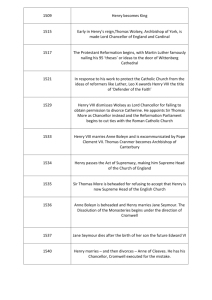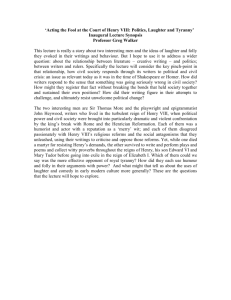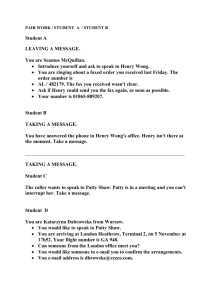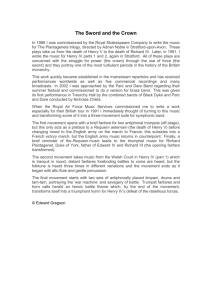ctime819_Martyrdoms_under_Henry_VIII
advertisement
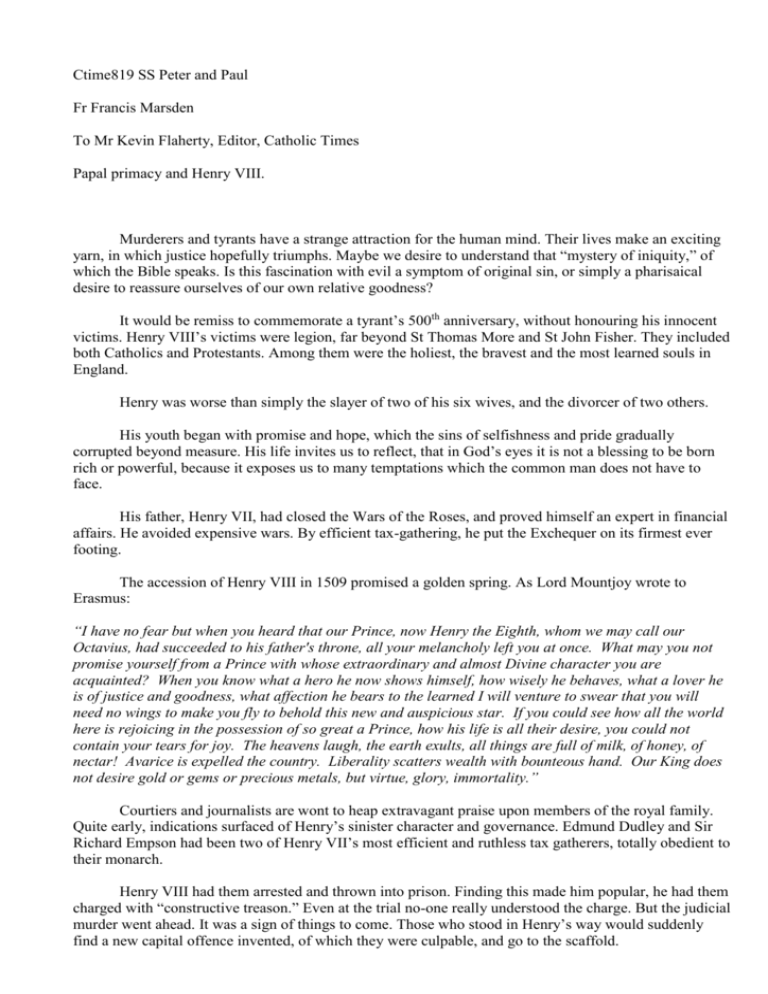
Ctime819 SS Peter and Paul Fr Francis Marsden To Mr Kevin Flaherty, Editor, Catholic Times Papal primacy and Henry VIII. Murderers and tyrants have a strange attraction for the human mind. Their lives make an exciting yarn, in which justice hopefully triumphs. Maybe we desire to understand that “mystery of iniquity,” of which the Bible speaks. Is this fascination with evil a symptom of original sin, or simply a pharisaical desire to reassure ourselves of our own relative goodness? It would be remiss to commemorate a tyrant’s 500th anniversary, without honouring his innocent victims. Henry VIII’s victims were legion, far beyond St Thomas More and St John Fisher. They included both Catholics and Protestants. Among them were the holiest, the bravest and the most learned souls in England. Henry was worse than simply the slayer of two of his six wives, and the divorcer of two others. His youth began with promise and hope, which the sins of selfishness and pride gradually corrupted beyond measure. His life invites us to reflect, that in God’s eyes it is not a blessing to be born rich or powerful, because it exposes us to many temptations which the common man does not have to face. His father, Henry VII, had closed the Wars of the Roses, and proved himself an expert in financial affairs. He avoided expensive wars. By efficient tax-gathering, he put the Exchequer on its firmest ever footing. The accession of Henry VIII in 1509 promised a golden spring. As Lord Mountjoy wrote to Erasmus: “I have no fear but when you heard that our Prince, now Henry the Eighth, whom we may call our Octavius, had succeeded to his father's throne, all your melancholy left you at once. What may you not promise yourself from a Prince with whose extraordinary and almost Divine character you are acquainted? When you know what a hero he now shows himself, how wisely he behaves, what a lover he is of justice and goodness, what affection he bears to the learned I will venture to swear that you will need no wings to make you fly to behold this new and auspicious star. If you could see how all the world here is rejoicing in the possession of so great a Prince, how his life is all their desire, you could not contain your tears for joy. The heavens laugh, the earth exults, all things are full of milk, of honey, of nectar! Avarice is expelled the country. Liberality scatters wealth with bounteous hand. Our King does not desire gold or gems or precious metals, but virtue, glory, immortality.” Courtiers and journalists are wont to heap extravagant praise upon members of the royal family. Quite early, indications surfaced of Henry’s sinister character and governance. Edmund Dudley and Sir Richard Empson had been two of Henry VII’s most efficient and ruthless tax gatherers, totally obedient to their monarch. Henry VIII had them arrested and thrown into prison. Finding this made him popular, he had them charged with “constructive treason.” Even at the trial no-one really understood the charge. But the judicial murder went ahead. It was a sign of things to come. Those who stood in Henry’s way would suddenly find a new capital offence invented, of which they were culpable, and go to the scaffold. Henry was a Catholic who liked to portray himself as a “supercatholic,” provided he got his own way. For his attack on Luther in the Assertio Septem Sacramentorum, the Pope granted him the title “Defender of the Faith.” Later, when Catholicism didn’t suit him, when the Pope insisted he remain faithful to his legitimate wife, Catherine of Aragon, Henry decided to change the rules to suit himself. Unlike most men, he was in a position to change the rules, even if it meant taking England into schism from the rest of Christendom. If sin is - as Augustine wrote - the “libido dominandi”, the lust to dominate, the life of Henry VIIII provides a salutary warning of where that libido uncontrolled may lead. The details of “the King’s great matter,” his divorce from Queen Catherine to marry Ann Boleyn, are well-known, and will not be repeated here. The 1535 Act of Supremacy declared it high treason to deny that the King was Supreme Head of the Church in England. The monks of the London Charterhouse were the first invited to take the oath, recognising Henry VIII in his new spiritual role. Realising the choice lay between apostasy and martyrdom, the community had recourse to prayer and fasting, and celebrated the Mass of the Holy Spirit. One eye-witness wrote: “Suddenly there came from heaven—all of us heard and wondered—a pleasant sound like the voice of a gentle breeze, charming our outward ears as with a sweet breath, and then gently striking them with a softly whispered murmur.” In this way, God strengthened them for the ordeal they must endure. St John Houghton, prior of the London Charterhouse, St Robert Lawrence, Prior of Beauvale (Notts), and St Augustine Webster, Prior of Axholme, approached Thomas Cromwell to beg for exemption from taking the oath. Cromwell received them rudely, and had them committed to the Tower. On April 28th 1535 they were tried in Westminster Hall, for refusing to take the oath, and condemned. On May 4th, Sir Thomas More, as he watched them being dragged on hurdles from the Tower, remarked to his daughter, “See how the blessed fathers go to their deaths as cheerfully as bridegrooms to a marriage.” At Tyburn they were hanged, drawn and quartered. As the butcher disembowelled Houghton, the martyr cried out: “Good Jesus, what will you do with my heart?” With the three Carthusians that day suffered also Bd John Haile, a secular priest and vicar of Isleworth, and St Richard Reynolds, Bridgetine priest, known as “the angel of Syon Abbey.” Reynolds was one of the most learned and holy men of his day. At his trial he had bravely defended the unity of the Church: Whatever Parliament, the lords and bishops of England might say, Reynolds argued, the Pope’s – and not the King’s - spiritual primacy was upheld by all the rest of Christendom, all the General Councils, the Holy Doctors of the Church for the last 1500 years. He was told to hold his tongue. After the martyrdoms, Houghton’s arm was nailed above the entrance of the London Charterhouse. This savagery did not frighten his brothers. On 19th June, Bd Humphrey Middlemore, William Exmew and Sebastian Newdigate died similarly at Tyburn. Bd John Rochester and Bd James Walworth were hanged in chains at York on 11 May 1537. The remaining monks, still recalcitrant, were dragged to Newgate prison and chained to stakes to be starved to death. They died between 8th June and 20th September 1537, except for a lay-brother, Bd William Horne, who inexplicably survived the death cells. He was transferred to the Tower, until hanged, drawn and quartered on 4th August 1540. Cromwell proceeded also against the Observant Franciscans, who especially at Greenwich had a public record of preaching against the King’s marriage with Ann Boleyn. All seven of their monasteries were closed, and up to 220 friars were thrown into prison. At least 32 of them died there, left to starve or to rot to death in their own filth. One Franciscan, John Forest, confessor to Queen Catherine, was burned at Smithfield on 22 May 1538, and has been declared Blessed. Friars Belchiam, Brookby, and Cort were pronounced Venerable, but for the rest, their names and deaths went unchronicled. The historical data required is lacking. The canonization causes of these Franciscan martyrs for the faith cannot proceed. Thus the English province of the Order of Observant Friars passed into glory. With the destruction of the monasteries, hostility was directed against uncooperative Benedictines. Blessed Richard Whiting, Abbot of Glastonbury, and two of his monks were hanged, drawn and quartered at Glastonbury on 15th November 1539. That same day, Bl Hugh Faringdon, Abbot of Reading and two of his monks were executed similarly. Bl John Beche, abbot of Colchester, was killed on 1st December. Next came the turn of the secular clergy to become Beati: Thomas Abel D.D., chaplain to Queen Catherine; Edward Powell, headmaster of Eton and vicar of St Mary Redcliffe, Bristol; Richard Fetherston, Archdeacon of Brecon and tutor to Princess Mary, were killed at Smithfield on 30 July 1540. Then two knights of St John of Jerusalem, the chancellor of St Patrick’s cathedral, Dublin, the Vicar of Wandsworth, the parish priest of Calais, the rector of Chelsea, the secretary to the bishop of Winchester…..the terror had come. The shadow of Tudor religious persecution would blight the British Isles for the next four centuries. Finally and most vindictively¸ Henry ordered the death of the 67 year old Bd Margaret Pole, Countess of Salisbury, whose beautiful chantry chapel still stands in Christchurch Priory, Bournemouth. Cromwell wrote that the family had “little offended save that he [the Cardinal] is of their kin.” Her crime was to be a Plantagenet and the mother of Cardinal Reginald Pole, who in Rome had opposed the royal divorce. Her head was clumsily hacked off at Smithfield on 28th May, 1541. It is more fitting, surely, that we celebrate these holy martyrs, than the wicked king who engineered their deaths.




